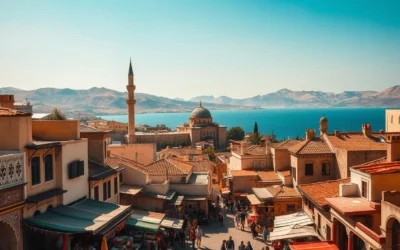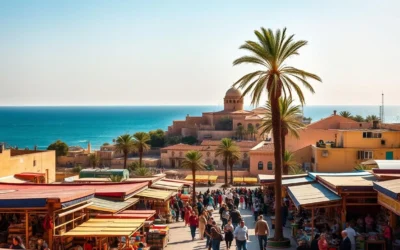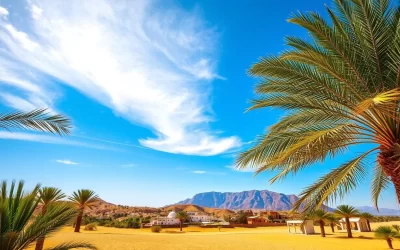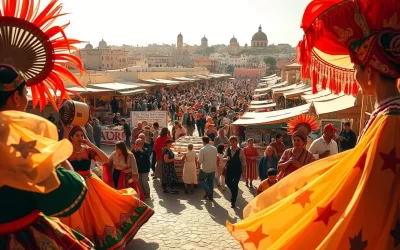✓ Accommodations✓ Flights✓ Rental Cars
Discover the captivating capital of Tunisia, where North African and Mediterranean influences blend in a unique cultural melting pot. You can explore the rich history, vibrant culture, and stunning architecture that makes Tunis a standout destination.
Your journey in Tunis will be filled with exciting experiences, from visiting ancient ruins to relaxing on beautiful beaches. This guide will walk you through the top attractions, neighborhoods, and cultural experiences that Tunis has to offer, along with practical tips to make your travel smooth and enjoyable.
Tunis is an affordable destination, making it easy for you to get around and enjoy local cuisine like kafteji, lablebi, and makroudh. Whether you’re interested in history, food, or cultural immersion, Tunis has something for every type of traveler.
Discovering the Charm of Tunis
As you explore Tunis, you’ll discover a city where history and modernity blend seamlessly. This captivating mix is evident in its architecture, dining, and overall lifestyle, making Tunis a unique place to visit.
A Brief Introduction to Tunisia’s Capital
Tunis, the capital city of Tunisia, is a fascinating mix of ancient traditions and modern influences. As the political, economic, and cultural capital, Tunis has a rich history dating back to ancient times. Its geographical location along the Mediterranean coast has made it a significant historical trading hub. The people of Tunis are known for being open, kind, and honest, adding to the city’s charm.
The city’s proximity to Europe, particularly Italy, has influenced its fashion, architecture, and dining, while maintaining its traditional culture. You can enjoy a beer on a patio overlooking the sea or spend a day in your bikini getting a tan at the beach, showcasing the city’s progressive and relaxed vibe.
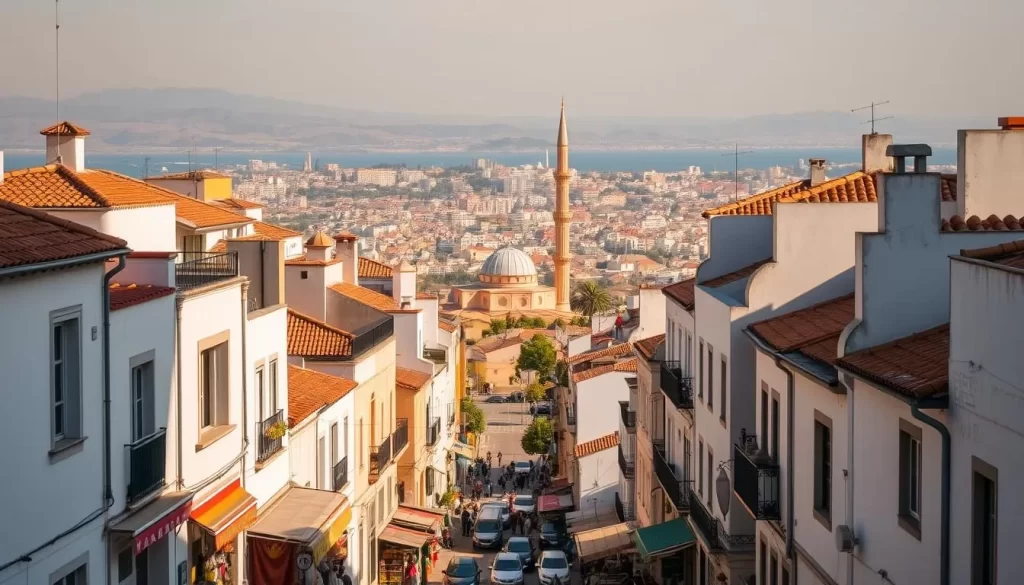
Best Time to Visit Tunis
The best times to visit Tunis are during the spring (April-May) and fall (September-October) seasons, when temperatures are mild and pleasant. These periods are ideal for exploring the city’s historical sites and enjoying outdoor activities.
| Season | Weather | Activities |
|---|---|---|
| Spring (April-May) | Mild temperatures | Explore historical sites, enjoy outdoor activities |
| Summer | Hot | Great beach opportunities |
| Fall (September-October) | Mild temperatures | Explore historical sites, enjoy outdoor activities |
| Winter | Mild but can be rainy | Indoor activities, cultural experiences |
While summer can be hot, it’s perfect for beachgoers. Winters are mild but can be rainy, making it a good time for indoor activities and cultural experiences.
Exploring the Historic Tunis Medina
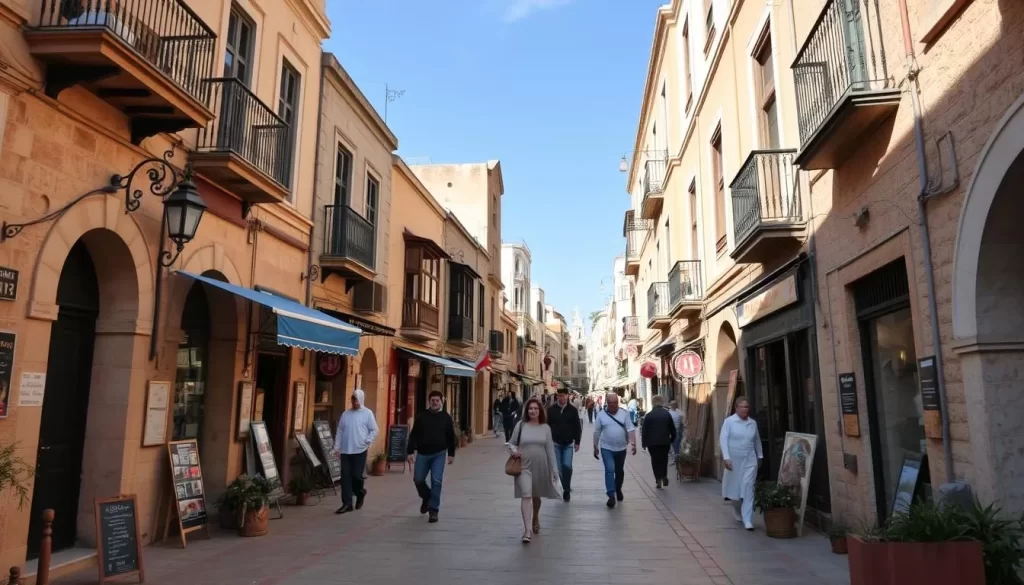
As you step into the Tunis Medina, you’re immediately immersed in a world of ancient history and vibrant culture. This UNESCO World Heritage site is one of the best-preserved Islamic cities in the world, offering a unique blend of traditional and modern life.
Navigating the Labyrinthine Souks
The Tunis Medina is characterized by its narrow, winding streets and bustling souks, where you can find everything from traditional textiles and ceramics to local spices. To navigate these labyrinthine markets, it’s best to visit mid-week to avoid the crowds that flock to the area on Saturdays. Be prepared to haggle with local merchants, as bargaining is a part of the culture.
As you explore the souks, you’ll discover a variety of goods on offer, from intricately woven fabrics to beautifully crafted pottery. Don’t be afraid to venture down side alleys, as they often lead to hidden gems and unexpected experiences.
Must-Visit Landmarks Within the Medina
Among the many landmarks within the Tunis Medina, the Great Mosque of Ez-Zitouna stands out as one of the oldest in the Maghreb region. This historic mosque, along with traditional fondouks or merchant inns, provides a glimpse into the rich history and cultural heritage of the area. Be sure to visit these sites to appreciate the architectural and historical significance of the Medina.
Best Rooftop Views of the Medina
For a panoramic view of the Tunis Medina, head to one of the many rooftop cafes or viewpoints. From here, you can admire the minarets, domes, and terraces that characterize the Medina’s skyline. It’s a great way to appreciate the layout of the ancient city and capture some memorable photos.
Visiting the Tunis Medina is an unforgettable experience, with its rich history, vibrant culture, and stunning architecture. Whether you’re exploring the souks, visiting historic landmarks, or simply taking in the views, the Medina has something to offer every kind of traveler.
Uncovering Ancient History at Carthage
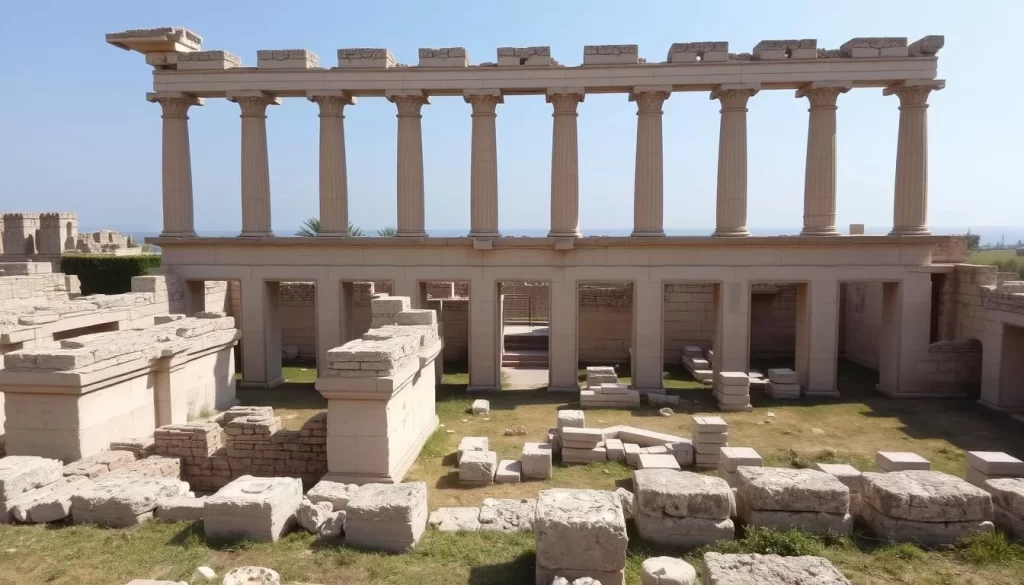
As you step into Carthage, you’re about to uncover the remnants of a civilization that once rivaled ancient Rome. Located just outside Tunis, Carthage is an ancient city and a UNESCO World Heritage site, founded by the Phoenicians in the 9th century BC. The history of Tunis starts here, at the site of the old Carthaginian Empire, before it was attacked and defeated by the Romans.
The Roman Amphitheater and Theatre
The Roman Amphitheater and Theatre are testaments to the city’s historical significance and architectural prowess. The Amphitheater, with its impressive structure, once hosted gladiator battles and public events, while the Theatre showcases the city’s rich cultural heritage. As you explore these ruins, you can almost hear the echoes of the past.
Antonine Baths and Other Archaeological Sites
Carthage is home to numerous archaeological sites, including the impressive Antonine Baths, which were once the largest Roman baths outside Rome. Other key sites include the Villas Romaines, Theatre Romain, and the Quartier Magon, each offering a glimpse into the city’s rich history. The Antonine Baths, in particular, are a highlight, showcasing the engineering and architectural skills of the ancient Romans.
Tips for Visiting the UNESCO World Heritage Site
Visiting Carthage is a journey through time. The site is spread out over several kilometers, and a ticket costing 12 TND (4 USD) grants access to multiple archaeological sites, including the Amphitheatre, Villas Romaines, and the Antonine Baths. For the best experience, visit early in the morning to avoid the heat and crowds. Be sure to explore the various sites and take in the historical significance of this ancient city.
Admiring Art and History at the Bardo Museum
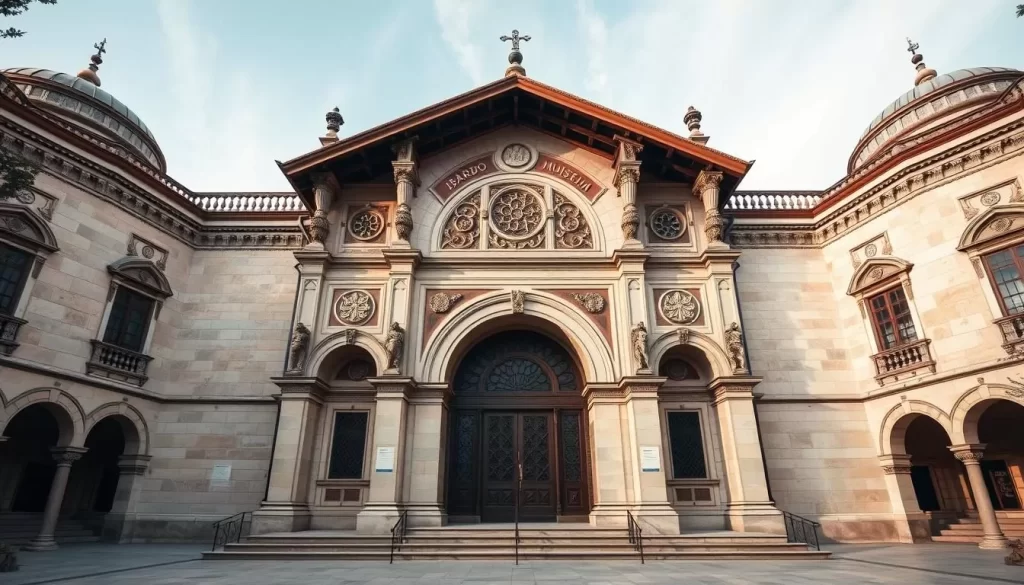
As one of North Africa’s most significant cultural institutions, the Bardo Museum in Tunis is a must-visit destination. Housed in a former Ottoman-era palace, this museum is a treasure trove of art and history, boasting an impressive collection that spans centuries.
The World’s Largest Collection of Roman Mosaics
The Bardo Museum is celebrated for its extensive and exquisite collection of Roman mosaics, considered the largest and most impressive in the world. Among its highlights are the famous Virgil and Ulysses mosaics, which exemplify the artistic prowess of ancient civilizations. As you explore the museum, you’ll be struck by the intricate details and vibrant colors of these Roman mosaics, which adorn the walls and floors.
The museum’s collection is not limited to mosaics alone; it also includes a vast array of statues and artifacts recovered from the site of Carthage, providing a comprehensive insight into the history and culture of the region. The informational boards throughout the museum offer detailed explanations of the exhibits, enriching your understanding of this ancient civilization.
Practical Information for Museum Visitors
To make the most of your visit to the Bardo Museum, it’s essential to plan ahead. The museum is open from 9:30 am to 4:30 pm, and it’s advisable to arrive early to avoid the crowds that gather later in the day. The admission fee is 13 TND, payable in cash only. You can expect to spend around 2-3 hours exploring the museum’s vast collection.
Visitors can also enjoy the serene ambiance of the Cafe Andalous, located in the museum’s garden, where you can relax over a cup of tea or coffee. With its rich history, stunning architecture, and world-class exhibits, the Bardo Museum is an unmissable place to visit when in Tunis, offering a truly enriching experience.
Strolling Through the Blue and White Village of Sidi Bou Said
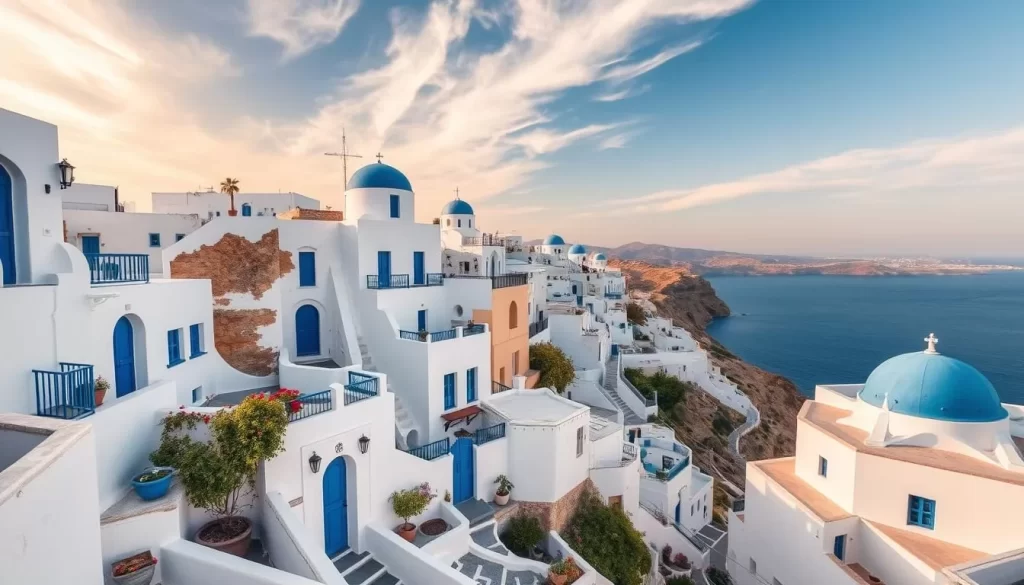
Perched on a cliff overlooking the Mediterranean Sea, Sidi Bou Said is a picturesque village that captivates visitors with its blue and white charm. Often compared to Santorini, this charming village is a must-visit destination in Tunis, attracting tourists and artists alike with its unique aesthetic.
Exploring the Picturesque Streets
The village’s cobblestone streets are lined with whitewashed buildings adorned with striking blue doors and window frames, creating a visually stunning atmosphere. As you wander through the narrow alleys, you’ll discover the village’s rich history and artistic heritage, which has drawn famous artists and writers like Paul Klee and André Gide.
Sidi Bou Said‘s artistic vibe is palpable as you explore its charming shops and street vendors selling local crafts and souvenirs.
Best Cafés and Viewpoints
One of the highlights of visiting Sidi Bou Said is enjoying a café au lait at one of its many charming cafes, such as the iconic Café des Délices. This picturesque café offers panoramic views of the Gulf of Tunis, making it a perfect spot to relax and soak in the beauty of the surroundings.
Shopping for Authentic Souvenirs
As you explore the village, you’ll find numerous shops selling traditional crafts, perfumes, and unique souvenirs. Be sure to haggle and compare prices to avoid tourist traps and overpricing. Authentic souvenirs such as intricately designed bird cages and local handicrafts make for memorable keepsakes.
Relaxing in La Marsa and La Goulette
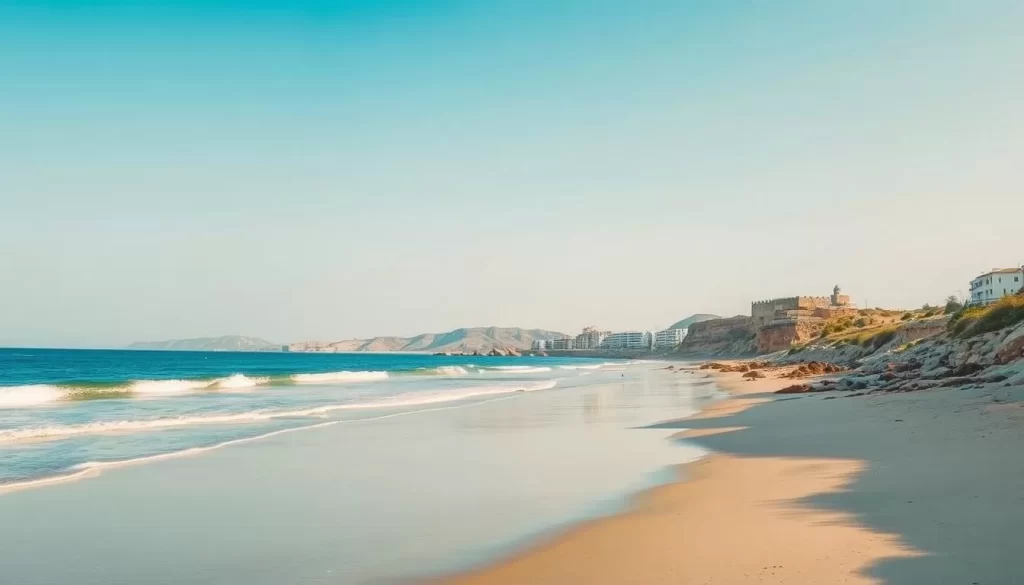
Escape to the coastal charm of La Marsa and La Goulette, Tunis’s upscale seaside suburbs. These areas offer a tranquil retreat from the city’s hustle and bustle, inviting you to unwind in a beautiful setting.
Beach Activities and Waterfront Experiences
La Marsa is renowned for its beautiful sandy beach and relaxed atmosphere, making it the perfect spot for sunbathing, swimming, and various water sports. You can enjoy a range of activities or simply bask in the sun. La Goulette, with its historical significance as Tunis’s port area, offers a unique waterfront experience.
Both areas provide a serene beach experience, with La Goulette being particularly famous for its seafood. You can take a leisurely walk along the boardwalk, enjoying the views and the local cuisine.
Dining by the Mediterranean Sea
La Marsa and La Goulette are dotted with excellent restaurants and cafes, offering a range of dining experiences. From casual beachside eateries to upscale restaurants serving fresh Mediterranean cuisine, there’s something for every taste.
As you enjoy your meal in these picturesque areas, you’ll feel like you’re in a tranquil part of the world, far from the city’s chaos. La Goulette, in particular, is a great place to savor seafood while watching the sunset.
Experiencing Tunisian Cuisine in Tunis

The flavors of Tunisia come alive in Tunis, offering a culinary adventure like no other. Tunisian cuisine is a true celebration of flavors, blending Mediterranean influences with North African flair. As you explore the city, you’ll discover a rich culinary heritage that is both diverse and vibrant.
Must-Try Traditional Dishes
Tunisian cuisine boasts a variety of delicious dishes that are sure to tantalize your taste buds. You must try couscous, the national dish, often served with vegetables and meat. Another favorite is brik, a crispy pastry filled with egg and sometimes meat or tuna. Don’t miss tajine, a hearty dish different from its Moroccan counterpart, and makloub, a flavorful stuffed bread.
The use of harissa, a spicy chili paste, and olive oil is prevalent in Tunisian cooking, adding depth and richness to the dishes. The abundance of fresh seafood along the coast also means that seafood dishes are a staple in many Tunisian meals.
Top Restaurants and Street Food Spots
For an authentic dining experience, head to local restaurants in Tunis, ranging from upscale establishments to family-run eateries. Be sure to visit the lively markets and try street food like lablabi (chickpea soup) and bambalouni (fried doughnut).
Whether you’re in the mood for a sit-down meal or a quick snack, Tunis offers a wide range of options to satisfy your culinary cravings. Enjoy exploring the city’s cuisine, and don’t hesitate to try new dishes and flavors.
Tunis, Tunisia: Best Things to Do – Top Picks for Cultural Experiences
As you explore Tunis, you’ll discover a rich tapestry of cultural experiences that go beyond the typical tourist attractions. The city offers a unique blend of traditional and modern culture, allowing you to immerse yourself in the local way of life.
Traditional Hammams and Spas
A visit to a traditional Tunisian hammam is a must-do cultural experience. Hammams are an integral part of Tunisian culture, providing a space for socializing and relaxation. You can rejuvenate at one of the many excellent spas and bathhouses in the city, such as Dar Hi or Les Thermes de Carthage, which offer a range of treatments inspired by traditional practices.
These hammams and spas not only provide a relaxing experience but also give you insight into the local culture and traditions.

Local Festivals and Events
Tunis hosts various festivals and events throughout the year, showcasing its rich cultural heritage. The International Festival of Carthage is a highlight, featuring music, dance, and theater performances. You can also experience the vibrant atmosphere during Ramadan celebrations, where you can enjoy traditional food, music, and cultural events.
These events provide a unique opportunity to engage with the local community and experience the city’s cultural traditions firsthand.
Art Galleries and Cultural Centers
Tunis has a thriving art scene, with numerous galleries and cultural centers showcasing local and international art. The Bardo Museum is a prominent cultural institution, housing an impressive collection of art and artifacts. You can also explore contemporary art spaces like La Galerie d’Art Contemporain, which features works by Tunisian and international artists.
By visiting these cultural centers, you can gain a deeper understanding of Tunisian art, history, and culture, making your visit to Tunis more meaningful and enriching.
Day Trips and Excursions from Tunis
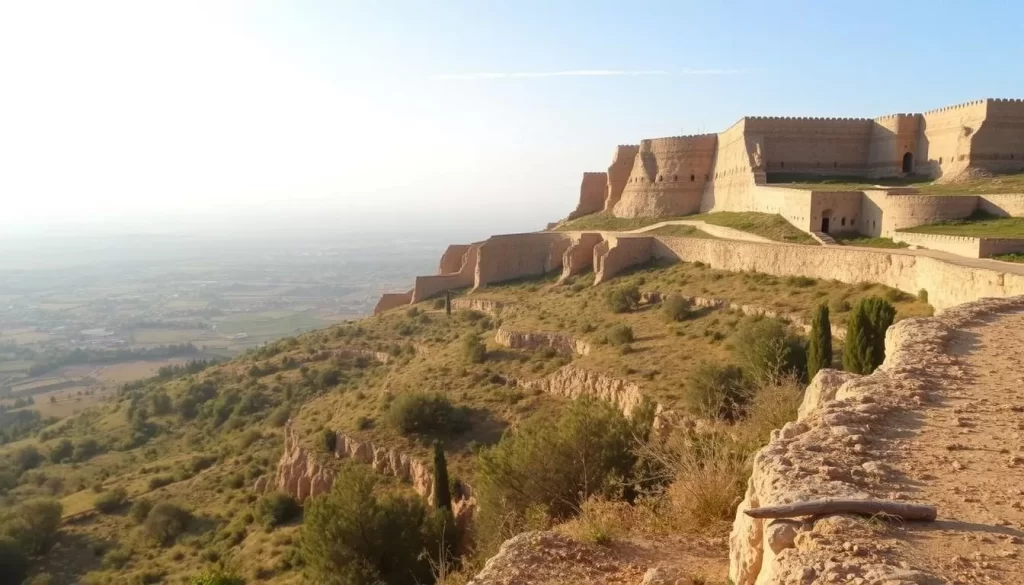
From Tunis, you can easily explore the surrounding region, visiting historic sites, coastal towns, and natural wonders. The city’s strategic location makes it an ideal base for day trips to various attractions in northern Tunisia.
Nearby Coastal Towns Worth Visiting
One of the charming coastal towns near Tunis is Hammamet, known for its beautiful beaches and historic medina. You can enjoy water activities or simply relax on the beach. Another picturesque destination is Sidi Bou Said, famous for its blue and white architecture and stunning views of the Mediterranean.
Organized Tours and Transportation Options
To make the most of your day trips, you can choose from various organized tours and transportation options. Public transportation is available, or you can opt for private drivers for a more personalized experience. Visiting archaeological sites like Dougga and Bulla Regia, which offer impressive Roman ruins, becomes convenient with these options.
Whether you’re a tourist looking for cultural experiences or an adventure-seeker, Tunis provides a convenient travel base to explore northern Tunisia’s diverse landscapes and attractions.
Practical Travel Tips for Visiting Tunis
To make the most of your visit to Tunis, here are some practical travel tips to keep in mind. The official languages are Arabic and French, but you’ll find that many people, particularly in the service industry, speak English, German, and Russian.
When it comes to getting around, Tunis has an efficient light rail system that connects major areas of the city. You can also hire taxis or walk, but be aware that the streets can be quite labyrinthine. For accommodations, consider staying in areas like the Medina or Sidi Bou Said, which offer a mix of traditional and modern amenities.
Some other essential things to keep in mind include: being mindful of local customs and dress codes, carrying cash as few places accept credit cards, and being prepared for spicy food. Additionally, consider purchasing a local SIM card at the airport to stay connected during your trip. By being aware of these travel guide tips, you can have a more enjoyable and stress-free experience in this vibrant capital city.
The above is subject to change.
Check back often to TRAVEL.COM for the latest travel tips and deals.

